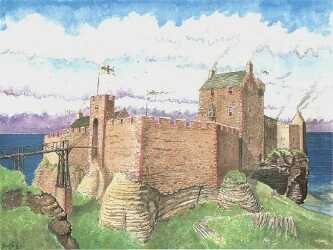
Girnigoe castle of the Sinclair Clan
Sinclair and St Clair Clans
Two important families bearing the name of Sinclair (or St Clair) co-existed in the 12th century, distinguished as of Rosslyn, in Midlothian, and of Herdmanstoun, in East Lothian. Though no relationship can be traced between them, the earlier bearers of the title of Lord Sinclair belonged to the Sinclair branch of the family.
The town of St Clare lay in Pont d’Eveque in Normandy, and was the birthplace of this great northern clan. Walderne de Santo Claro accompanied William the Conqueror on his invasion of England in 1066. His son by Margaret, daughter of Richard of Normandy, was one of the many Anglo–Norman barons who came north to settle in Scotland during the reign of David I. William de Santo Claro was granted the barony of Roslin just south of Edinburgh, and this was confirmed to his son, Sir William St Clair of Roslin, in 1180. .... more
- A1. Walderne de Sancto Claro, lvd:1047/1066, m. Margaret de Normandie;
==> The Normans
- B1. William de St Clair of Rosslyn;
- C1. Henri de St Clair of Rosslyn, lvd:1093/1096, m. Agnes de Dunbar;
- D1. Sir Henry St Clair of Rosslyn;
- E1. Sir Henry, Baron of Rosslyn, lvd:1243/1270;
- F1. N. St Clair, m. Cailein Mór Campbell; ==> Clan Campbell
- F2. Sir Henry, Baron of Rosslyn, lvd:1243/1270;
- G1. Sir William St Clair of Rosslyn, m. Amicia;
<========
- G1. Sir William St Clair of Rosslyn, m. Amicia;
- E1. Sir Henry, Baron of Rosslyn, lvd:1243/1270;
- D1. Sir Henry St Clair of Rosslyn;
- C1. Henri de St Clair of Rosslyn, lvd:1093/1096, m. Agnes de Dunbar;
- H1. Sir Henry St Clair of Pentland, m. Alice de Fenton;
- I1. Margaret Sinclair, m1. Thomas Stewart,;
==> Clan Stewart
m2. Sir William St. Clair- J1. [m2]: Sir John St Clair of Herdmanston, lvd:1396;
- K1. Sir William St Clair of Herdmanston, lvd:1413;
- L1. Caterine St Clair, m. Sir John de Seton; <== Clan Seton
- K1. Sir William St Clair of Herdmanston, lvd:1413;
- J1. [m2]: Sir John St Clair of Herdmanston, lvd:1396;
- I2. Sir William Sinclair of Roslin, lvd:1330/1358, m. Isabella Strathearn;
==> Earls of Strathearn
- J1. Richard Sinclair, m. Joanna de Fynlatyr;
- K1. John Sinclair;
- L1. John Sinclair of Deskford and Findlater, d:1411;
- M1. Margaret Sinclair, m. Sir Walter Ogilvy; <== Clan Ogilvy
- L1. John Sinclair of Deskford and Findlater, d:1411;
- K1. John Sinclair;
- J2. Prince Henry Sinclair
of Orkney, lvd:1345/1400, m. Jean Halyburton;
- K1. Catherine Sinclair, m. Sir John Drummond; ==> Clan Drummond
- K2. Sir Henry, 2 nd Earl of Orkney, lvd:1375/1421, m. Egidia Douglas;
==> Clan Douglas
- L1. Sir William, 3rd Earl of Sinclair, lvd:1403/1480, m1. Elisabeth Douglas, m2. Marjory Sutherland;
- M1. [m1] Catherine Sinclair, m. Alexander Stewart; <== House of Stewart
- M2. [m1] William Sinclair, 2nd Lord, lvd:1435/1487, m. Christina Leslie;
==> Clan Leslie
- N1. Henry Sinclair, lvd:1460/1513, m. Margaret Hepburn;
- O1. Helen Sinclair, m. James Ogilvy; <== Clan Ogilvy
- N1. Henry Sinclair, lvd:1460/1513, m. Margaret Hepburn;
- M3. [m2] Eleanor Sinclair, m. John Stewart; <== Clan Stewart
- L1. Sir William, 3rd Earl of Sinclair, lvd:1403/1480, m1. Elisabeth Douglas, m2. Marjory Sutherland;
- J1. Richard Sinclair, m. Joanna de Fynlatyr;
- I1. Margaret Sinclair, m1. Thomas Stewart,;
==> Clan Stewart
- B1. William de St Clair of Rosslyn;
